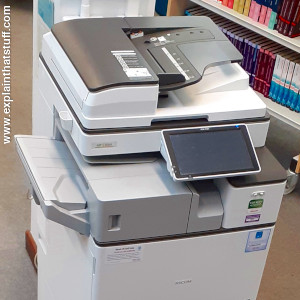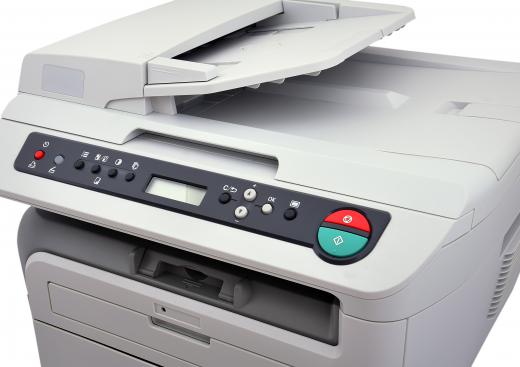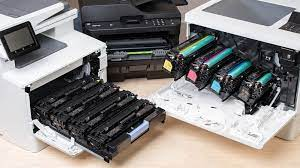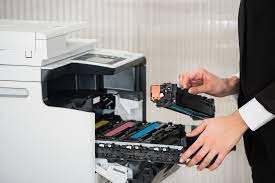Photocopiers, often referred to as copiers, are ubiquitous devices found in offices, schools, and libraries that play a crucial role in reproducing documents quickly and efficiently. These machines have become an indispensable tool for businesses and individuals alike. In this article, we will delve into the inner workings of photocopiers and explore the fascinating technology that enables them to produce accurate and high-quality copies.
Introduction
Photocopiers, a staple in modern offices, have revolutionized document reproduction. They allow users to duplicate text and images onto paper with remarkable precision and speed. Whether it’s a one-page document or a comprehensive report, photocopiers simplify the process of copying machine sharing information.
How Do Photocopiers Work: Basic Principles of Photocopying
At its core, the photocopying process relies on the principle of electrostatics. This involves the behavior of electric charges on the surface of materials and photographic paper. Photocopiers utilize a photosensitive drum and toner to create an image that can be transferred onto paper.
The Photocopying Process
The photocopying process can be broken down into several key steps:
- Exposure: The original document is placed face down on the glass surface, and a bright light scans across it. The light reflects off the document, and the resulting pattern of light and shadow is captured by the machine’s optics.
- Charging: The photosensitive drum is uniformly charged with static electricity. This creates an electrostatic image of the document’s content on the drum’s surface.
- Developing: Toner, a fine powder with electric properties, is attracted to the charged areas on the drum, forming a visible image.
- Transfer: The toner image is transferred from the drum onto a sheet of paper using an electrical charge.
- Fusing: The toner particles are heated and fused onto the paper, creating a permanent image.
Components of a Photocopier
A photocopier consists of several key components working together to produce a copy:
Photoreceptor Drum
The drum is a cylindrical element coated with a photosensitive material. It plays a pivotal role in capturing the electrostatic image of the original document.
Optics and Mirrors
Optical elements, such as lenses and mirrors, ensure that the light and reflected light back from the document is focused onto the drum’s surface accurately.
Developer Unit
The developer unit contains toner particles that are attracted to the charged areas on the drum, forming a visible image.
Transfer and Fusing Units
The transfer unit transfers the toner image from the drum to the paper, while the fusing unit applies heat and pressure to attract toner and permanently affix the toner to the paper.
Types of Photocopiers
Photocopiers can be broadly categorized into two types:
Analog Photocopiers
Analog photocopiers use traditional methods of optics and light to create copies. They are simple and reliable but lack the advanced features of digital photocopiers.
Digital Photocopiers
Digital photocopiers use digital imaging technology to scan and reproduce documents. They offer features such as image editing, multiple copy settings, and network connectivity.
Advancements in Photocopying Technology
Recent advancements have led to the development of multifunctional photocopiers digital machines that can also print, scan, and fax documents. Networked photocopiers allow seamless sharing and management of documents across multiple devices.
Maintaining and Troubleshooting Photocopiers
Proper maintenance is essential for prolonging the lifespan of a photocopier. Regular cleaning and replacing of consumables like toner and drums are crucial. Troubleshooting common issues like paper jams and poor image quality can help keep the machine running smoothly.
Environmental Impact and Sustainability
As technology evolves on the printing side, photocopier manufacturers are placing greater emphasis on sustainability. Energy-efficient models, recycled materials, and eco-friendly toners contribute to reducing the environmental footprint of these devices.
Future of Photocopying Technology
The future of photocopiers is intertwined with advancements in digital technology. Smarter AI-driven features, enhanced connectivity, and improved image quality are on the horizon for the first digital copiers, ensuring that photocopiers remain a vital tool in the modern workspace.
Toner Particles
Toner particles play a crucial role in modern printing technology, specifically in laser printers and photocopiers. These minuscule particles are responsible for transferring and fixing the image onto paper, producing the final printed or copied document.
Toner particles are typically composed of a powdered mixture of pigments or dyes, along with various polymers and other additives. These ingredients work together to create a charged powder that can adhere to an electrostatically charged surface, such as the drum or imaging unit within a laser printer.
The process of printing with toner involves several steps. First, an electrostatic image is created on the imaging drum using laser beams or other methods. The toner particles are then attracted to the charged areas on the drum, forming the image. Next, the toner-coated piece of paper drum transfers the image onto the paper, which is also given an opposite charge to attract the toner particles. Finally, heat is applied to fuse the toner particles onto the paper, creating a permanent image.
Digital Copier
A digital copier, often referred to simply as a “photocopier,” is a sophisticated office machine designed to reproduce documents quickly and efficiently. It employs digital technology to scan, process, and reproduce images or text from an original source onto paper. Digital copiers have revolutionized document reproduction by providing enhanced features, higher quality output, and increased versatility compared to their more analog copier predecessors.
The operation of a digital copier involves several key steps:
- Scanning: The original document is placed on the copier’s scanning glass or fed through an automatic document feeder (ADF). The copier uses an optical sensor to capture a digital image of the document.
- Image Processing: The scanned image is converted into digital data using complex algorithms. This data is then stored in the copier’s memory or transferred to a connected computer or network.
- Printing: Once the digital image is processed, the copier uses advanced printing techniques, such as laser or LED technology, to recreate the image on a blank sheet of paper. Toner particles are applied to the paper to form the desired image.
- Finishing Options: Digital copiers often offer various finishing options, such as collating, stapling, hole punching, and booklet creation, to streamline document production and improve document organization.
- Network Connectivity: Many digital copiers are equipped with network connectivity, allowing users to send print jobs directly from computers or mobile devices. This feature enhances convenience and productivity within a modern office environment.
Advantages of Digital Copiers:
- Speed and Efficiency: Digital copiers can produce copies at a faster rate compared to analog machines, saving valuable time in busy office settings.
- Image Quality: Digital technology enables precise reproduction of text and images, resulting in higher-quality copies that closely resemble the original.
- Versatility: Digital copiers can handle a wide range of paper sizes, weights, and types, making them suitable for various printing and copying tasks.
- Multi-functionality: Many digital copiers also function as printers, scanners, and even fax machines, providing comprehensive office solutions in a single device.
- Cost-effective: While initial investments may be higher, digital copiers often offer lower per-copy costs, especially for large-volume copying.
- Reduced Downtime: Digital copiers typically require less maintenance and experience fewer breakdowns, reducing downtime and improving overall office efficiency.
Laser Printer
A laser printer is a sophisticated type of printing device that uses advanced technology to produce high-quality text and images on paper. It operates by utilizing a laser beam to create an electrostatic image on a photosensitive drum, which is then transferred and fused onto paper using toner particles. Laser printers have become a staple in both office and home environments due to their speed, precision, and overall efficiency.
Key Features and Operation of a Laser Printer:
- Laser Scanning: The printing process begins with a laser beam that scans across the surface of a rotating photosensitive drum. This laser beam is guided by electronic signals from the computer or device sending the print job.
- Electrostatic Image Formation: The laser beam creates a temporary electrostatic image on the drum, where the positively charged areas correspond to the parts of the image to be printed.
- Toner Application: Toner particles, which are fine, powdered ink particles, are negatively charged. These particles are attracted to the positively charged areas on the drum, forming a toner image that mirrors the content to be printed.
- Transfer to Paper: The toner-coated drum comes into contact with a blank sheet of paper, transferring the toner image onto the paper’s surface. The paper is given a strong positive charge to attract the negatively charged toner particles.
- Fusing: The printed paper passes through a pair of heated rollers, known as the fuser unit. The heat and pressure from the fuser cause the toner particles to melt and fuse permanently onto the paper, creating a durable image.
Advantages of Laser Printers:
- High Quality: Laser printers produce sharp, crisp text and images, making them suitable for professional documents, reports, and presentations.
- Speed: Laser printers are known for their fast printing speeds, making them ideal for high-volume printing tasks.
- Precision: Laser technology allows for precise placement of toner particles, resulting in accurate and detailed output.
- Duplex Printing: Many laser printers offer automatic duplex (double-sided) printing, helping to save paper and reduce environmental impact.
- Wide Compatibility: Laser printers can handle a variety of paper types and sizes, as well as different document formats.
- Network Connectivity: Most laser printers offer network connectivity options, enabling multiple users to share the printer within an office environment.
- Low Operating Costs: Laser printers generally have lower cost-per-page compared to other printing technologies, especially when printing in bulk.
Laser printers have evolved over time, with advancements in technology leading to improved performance, energy efficiency, and connectivity options. Their ability to produce high-quality output quickly and reliably has made them an essential tool for businesses and individuals alike, contributing to efficient document management and communication.
Conclusion
Photocopiers have come a long way since their inception, transforming the way we duplicate and share information. With their intricate yet user-friendly technology, these machines continue to play a pivotal role in offices and businesses worldwide.
Frequently Asked Questions
- Are digital photocopiers more efficient than analog ones?
Digital photocopiers offer greater efficiency due to their advanced features and faster processing. - How often should I clean my photocopier?
It is advisable to clean your photocopier’s glass and other accessible parts at least once a week. - Can I use regular paper in a photocopier?
Yes, photocopiers are designed to work with standard copy paper. However, using recommended paper can yield better results. - What should I do if my photocopier frequently jams paper?
Paper jams are often caused by improper paper loading or worn-out rollers. Refer to your user manual for guidance on resolving jams. - Are there any security concerns with networked photocopiers?






Recent Comments